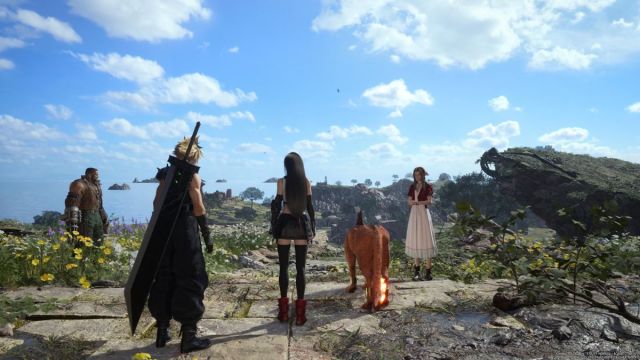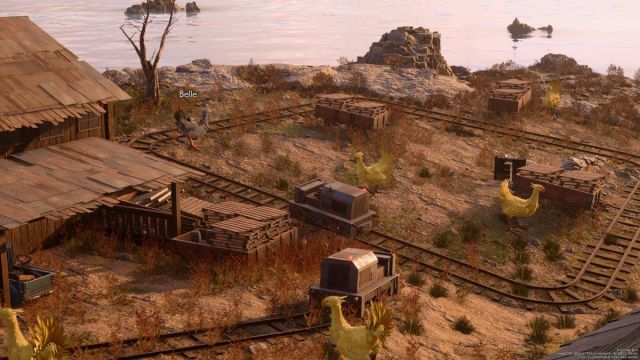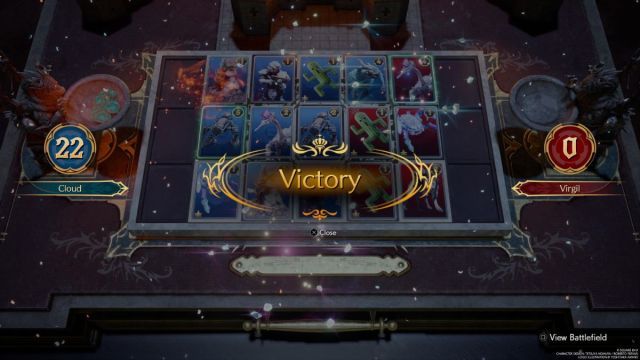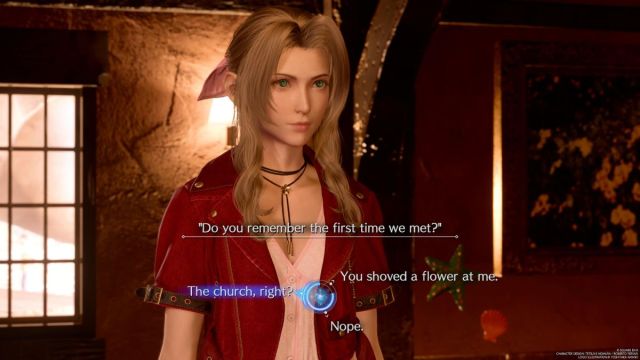As someone who, admittedly, isn’t great at committing to long video games because I’m either easily distracted or too busy with work, I wasn’t sure how I’d get on with Final Fantasy VII Rebirth. But as a lifelong Final Fantasy fan, I knew I’d have to try. And, spoiler alert, I am so, so glad I did. I couldn’t put it down. This review headline might seem a little strong, but it is genuinely the best video game ever made – or the best video game I’ve ever played, at least. But I’ve played a lot of games, and none of them really come close.
The story picks up right around where Final Fantasy VII Remake left off, with Cloud, Aerith, Tifa, Barret, and Red XIII escaping Midgar to the sanctity of Kalm, a village in the Grasslands. It’s there where he begins to fill his team in on what happened in Nibelheim five years prior and the events that led to Sephiroth becoming the ultimate evil. FF7 Rebirth doesn’t mess around, making you reach for the tissues just an hour or so into the story, and it doesn’t really let up throughout its 80-ish hours of the main campaign.

A Worldly Experience
After enjoying a brief moment of relaxation in Kalm, it’s not long until Shinra is hot on the heels of Cloud and his team once more, offering a stark reminder that they’ll never truly be able to live a normal life until their fight to save the planet ends. This is a recurring theme throughout Final Fantasy VII Rebirth, where you’re given little pockets of calm to enjoy each region before the tides quickly turn and you’re battling for your lives against a company so rotten to the core with greed, they’ll do literally anything to get world domination.
There are multiple regions to explore, each different than the last. For example, the Grasslands is filled with lush, green foliage and is a breeze to explore on Chocoboback. At the same time, Junon is dry, desolate, and overshadowed by a Shinra city that, much like Midgar, casts out its less-fortunate population to a poverty-stricken settlement below. Out of sight, out of mind, as they say. Shinra in a nutshell.

After meeting Chadley in the Grasslands, he sets Cloud a task: activate the Remnawave Towers in each region and complete Intel to help with his research. Finding a Remnawave Tower makes this Intel appear on your map, similar to a Ubisoft title, but better. There are so many different kinds of Intel; Expeditions see you digging up treasures with your Chocobo, while Moogle Intels transport you to magical lands to help the Moogles set up their shops in each region. There’s even Intel that makes fighting with some of Final Fantasy’s most famous Summons even easier, and let’s not forget the side quests. Numerous side quests help give insight into each region, and I’d highly recommend doing them.
The best part? It’s completely optional, for the most part. So if you’re someone who just wants to experience the story, you can. On the flip side, if you’re a completionist like me, you can waste tens, if not hundreds, of hours exploring each region and digging into everything it offers. I didn’t leave the Grasslands until almost 20 hours into my playthrough, and that was only because my husband reminded me that I couldn’t write a review based on one region, so I begrudgingly moved on. That’s not to say that you can’t return though, because you can, so you don’t need to worry about completing everything in a region in one go, which I really, really appreciated.

There’s also Queen’s Blood, a new card game that’s like Gwent from The Witcher 3 but, in my opinion, more fun – and that’s coming from someone who spent 200 hours in Gwent alone. It’s played on a five-by-three board, and the aim is to score the most points in each row. There are a handful of players to challenge in each region and, if you win, you get a cool card to add to your decks. Some stores even offer booster packs with new cards in them, making the chase for new cards for your deck part of your strategy to win.
“Queen’s Blood is brutal and heavily relies on strategy, which has you thinking about your every move – one wrong placement, and the game is over, even if you were winning by a landslide.”
But Queen’s Blood isn’t as simple as just putting cards down into spaces and tallying up the score at the end. Some cards decrease an opponent’s card’s points or boost the points of previously placed cards, while others outright destroy cards completely. Queen’s Blood is brutal and heavily relies on strategy, which has you thinking about your every move – one wrong placement, and the game is over, even if you were winning by a landslide. It’s unpredictable, but that’s what makes it so fun.

And then there’s the minigames. Oh, the minigames. There’s so much to unpack here. Want to take a break from fighting bad guys and getting your heart broken over and over? Why not head to Fort Condor, where you control a PS1-style team of troops to take down an evil warlord? If that’s not your jam, consider participating in Chocobo races or playing carnival games in Costa del Sol before you relax on the beach in swimwear that you’ve had to earn by playing said games.
There are so many weird and wacky activities to participate in at almost any given moment, which I really appreciated during my time with Final Fantasy VII Rebirth. Square Enix kept the goofiness from the original game and it translates over so well. I was afraid the dark themes of Rebirth would overshadow the PS1 game’s silliness, but it really doesn’t. You can tell how much heart and soul the developers put into ensuring that there are equal parts seriousness and balls-to-the-wall absurdity. And I truly love it.

Wait… Final Fantasy 7 Has Social Links?
One thing I really valued about Remake was the relationship between characters, and I was so happy to see that Final Fantasy 7 Rebirth not only adds to this but fully embraces it with choices that affect Cloud’s relationships with his party members. During all the chaos that ensues, you’re given brief moments where you can interact with his friends and choose a dialogue choice that can affect Cloud’s relationship with them. Say something they like, and you’ll get some relationship points, but answer incorrectly, and you’ll lose points. Choices matter here, making you weigh up every interaction, especially since you’ll get exclusive cutscenes with your top relationships throughout the game.
It’s not just Cloud’s relationships that stand out, though. It’s the party as a whole. All of Cloud’s traveling companions have so much love for each other (even if they don’t show it at times), and it’s so hard not to fall in love with everybody as a result. One of my favorite examples of this is when the team meets Yuffie in Under Junon in Chapter 4; while Barret is quickly fed up with her bubbliness, his normally stoic persona quickly turns to excitement when he thinks she’s after his autograph. It’s equally cute when he realizes she isn’t and becomes annoyed with her again. In classic Yuffie fashion, she takes advantage of his quick-to-annoyance personality for the rest of Final Fantasy VII Rebirth with playful jabs and jokes, even during the most serious times.

It may sound weird to say, but it’s almost like you’re traveling with your own friends during your playthrough. Your relationships with the cast transcend the screen, and I found myself thinking about them even when I wasn’t playing, looking forward to joining them on their escapades again in my next moment of spare time. Whether it was to continue the main story or simply hear their interactions as I explored an area. I can’t think of many games that have had that effect on me. It’s this that makes FF7 Rebirth’s emotional moments even more gut-wrenching. Because you care about everyone so much. And the game definitely has plenty of those.
“Your relationships with the cast transcend the screen, and I found myself thinking about them even when I wasn’t playing, looking forward to joining them on their escapades again in my next moment of spare time.”
These relationships also translate over to combat with Synergy Skills, which are special moves that sync Cloud up with another character. Using them not only provides neat effects during battle, such as temporarily gaining three ATB bars, but also strengthens Cloud’s relationship with that teammate. Like Limit Break, Synergy Skills activate over time, so you need to put the work in to be able to use them.

Combat is a Breeze
Synergy Skills aren’t the only great thing in Final Fantasy VII Rebirth’s combat system – combat as a whole is incredibly fluid and fun. If you played Remake, it is very similar but improved upon. Much of this shows in the playable characters, such as Yuffie, who uses Ninjitsu and a throwing star to inflict a fast flurry of attacks on enemies. She can even imbue her throws with elemental energy if you unlock certain moves in her Folio.
Folios is the skill tree system in FF7 Rebirth, reminiscent of the Sphere Grid from Final Fantasy X but less complicated. Each character has their own Folio with unlockable skills linked by Skill Cores nodes. You unlock Skill Cores using Skill Points, which are gained by raising your Party Level through side activities and building relationships with Cloud’s teammates. Each character’s Folio splits off into different paths that you can go down depending on your playstyle. For example, I chose Skills that allowed characters to use certain elemental moves without using up their MP, while others might prioritize nodes that increase overall stats like MP and HP.

While you’ll be using Cloud in battle for much of Final Fantasy 7 Rebirth, there are moments where you’ll be forced to play as other characters without Cloud in the party. This is why ensuring you utilize every character’s Folio effectively, even if you don’t have them in your active party most of the time, because you never know when you’ll be using them in certain sections of the game and you’ll want them at their best. This goes for setting their Materia, weapons, and accessories too.
In combat itself, you can set combination shortcuts so you don’t need to click into the Action menu and choose an action every time you want to move; you can simply press a particular button shortcut to execute it. This is so helpful during busy fights with enemies that leave little openings to figure out your next move and was a lifesaver for me during boss battles. It’s also incredibly useful during those sections where you play as other characters as their best moves will already be shortcutted for you if you put the time in to do so.

A Final Fantasy
There is only one thing I didn’t like in Final Fantasy VII Rebirth, and it’s an optional feature: Performance mode. I mentioned this in my FF7 Rebirth preview, but I really did not like how much the graphics suffered in Performance mode, and I was hoping this would change in the full release. In my opinion, the graphical fidelity is compromised too much for the sake of framerate. The game is absolutely beautiful, and while I wouldn’t have minded sacrificing some textures for a higher framerate, it’s not something I was able to do with the current state of Performance mode. Things just look a little too blurry for my taste. That said, the 30 frames-per-second in Graphics mode is completely fine, so not having a higher framerate didn’t bother me in the slightest. Sorry, but Sephiroth is too beautiful in Graphics mode – you’re not taking that from me.
Overall, Square Enix did Final Fantasy 7 so much justice with Final Fantasy VII Rebirth. With open-world regions filled with so much to do, beautiful world design, and a cast of characters worth giving a damn about, it really is, in my opinion, the best game ever made. I’m so excited for players to experience it and see exactly what I mean because the fact it’s a triumph is undeniable.
Just don’t forget to bring tissues because you will cry a lot. Like, a lot a lot. Seriously, Square Enix should have included a box of tissues with the Deluxe Edition because you’ll start weeping again just as you get a dry eye. And not always from sadness, either. It’s just that good.

- A gorgeous, rich world that never feels empty.
- Characters are much more fleshed out than Remake, and there's a 'Social Link' element added.
- So much side content.
- Graphics mode makes the game look incredibly beautiful.
- Has a soundtrack for the ages.
- Performance mode isn't worth the graphical decline unless you can't live without 60FPS.
- You will cry. A lot.





Published: Feb 22, 2024 09:00 am